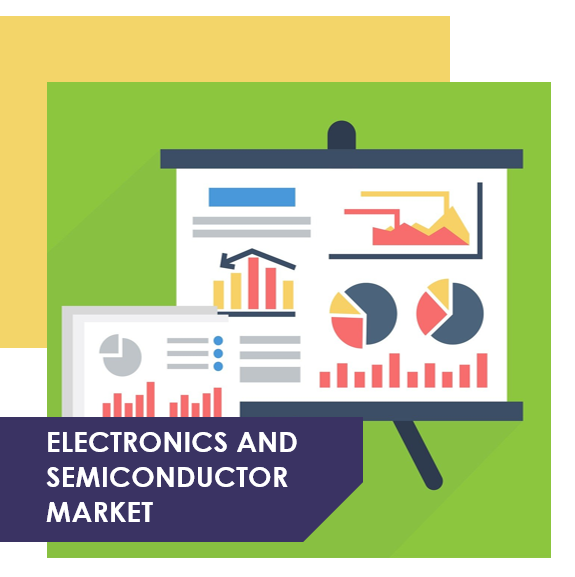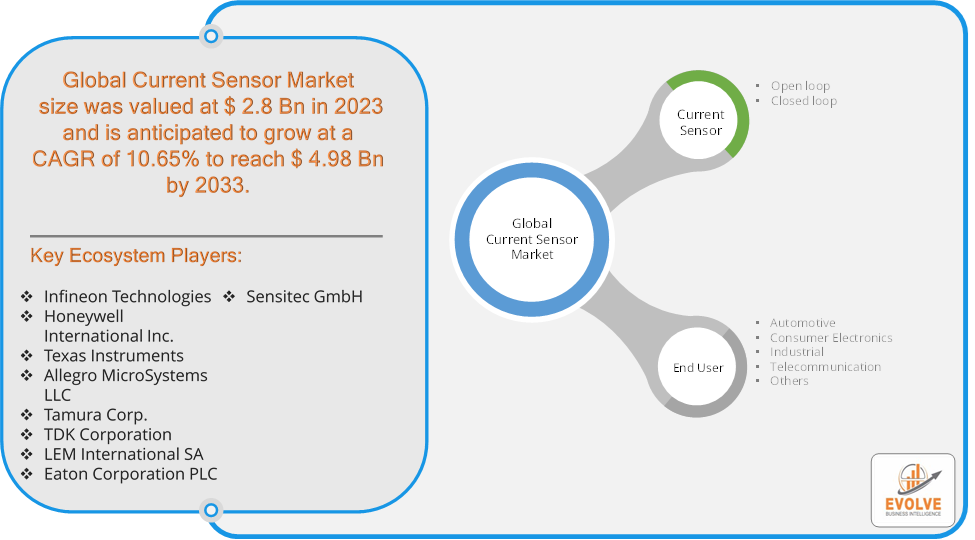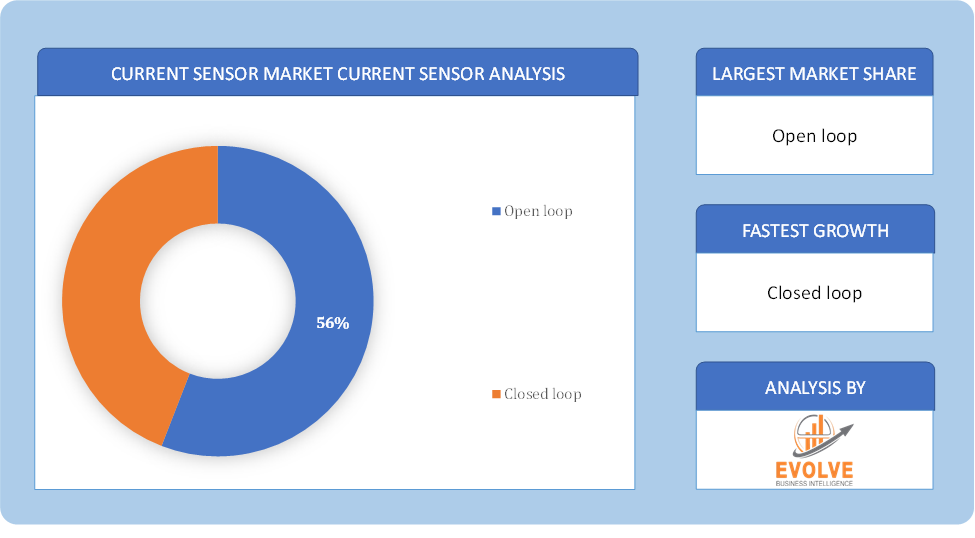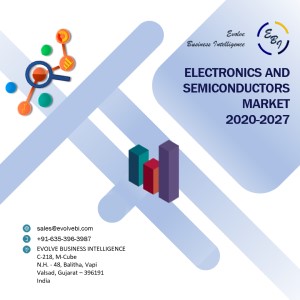Price range: $ 1,390.00 through $ 5,520.00
Current Sensor Market Research Report: Information By Current Sensor (Open loop, Closed loop), By End User (Automotive, Consumer Electronics, Industrial, Telecommunication, Others), and by Region — Forecast till 2033
Page: 180
Description
Current Sensor Market Overview
The Current Sensor Market Size is expected to reach USD 4.98 Billion by 2033. The Current Sensor Market industry size accounted for USD 2.8 Billion in 2023 and is expected to expand at a compound annual growth rate (CAGR) of 10.65% from 2023 to 2033. The Current Sensor Market refers to the global industry focused on the production, development, and sales of current sensors, which are devices used to measure and monitor the flow of electrical current in a circuit. These sensors are critical in various applications across industries, such as automotive, consumer electronics, industrial automation, healthcare, and energy management.
The Current Sensor Market is expected to grow significantly due to the increasing demand for energy-efficient solutions and the expansion of electric and hybrid vehicles, renewable energy systems, and automation technologies.
Global Current Sensor Market Synopsis
The COVID-19 pandemic had a significant impact on the Current Sensor Market. The pandemic caused significant disruptions in global supply chains, leading to delays in the production and delivery of current sensors. Lockdowns and restrictions affected factories, especially in key manufacturing hubs, resulting in temporary shutdowns or reduced operational capacity. The pandemic highlighted the need for efficient energy management, especially as work-from-home trends increased residential electricity consumption. This boosted demand for current sensors in power management applications, particularly in smart grids and renewable energy systems. The pandemic accelerated the development and deployment of medical devices, many of which rely on precise current sensing for proper functionality. This created new opportunities for current sensors in the healthcare sector. As companies adapted to pandemic-related challenges, there was an increased focus on automation and digitalization to maintain operations with reduced human intervention. This shift drove demand for current sensors in industrial automation and robotics.
Current Sensor Market Dynamics
The major factors that have impacted the growth of Current Sensor Market are as follows:
Drivers:
Ø Advancements in Consumer Electronics
The consumer electronics market’s demand for smaller, more portable devices has led to the development of compact, highly efficient current sensors. These sensors are used in devices such as smartphones, laptops, and wearable electronics to manage power consumption and extend battery life. The proliferation of smart home devices and IoT-enabled gadgets is driving the need for current sensors that can monitor and optimize power usage. Current sensors are increasingly used in medical devices and equipment, such as MRI machines, ventilators, and patient monitoring systems. The growth in the healthcare sector, driven by an aging population and increased healthcare spending, is boosting the demand for reliable and accurate current sensors.
Restraint:
- Perception of High Costs
Advanced current sensors, especially those with high precision and reliability, such as fluxgate sensors or closed-loop Hall effect sensors, can be costly to produce. The high cost of these sensors may limit their adoption, particularly in cost-sensitive markets or applications where budget constraints are significant. In developing regions, where price sensitivity is higher, the adoption of advanced current sensors may be slower due to their cost, limiting market penetration.
Opportunity:
⮚ Rising Adoption of Renewable Energy Systems
The increasing focus on renewable energy sources, such as solar and wind, is driving the need for current sensors in power generation, conversion, and distribution systems. Current sensors are used to monitor the flow of electricity in these systems, ensuring efficient energy conversion and grid stability. The growth of energy storage solutions, such as battery storage systems used in conjunction with renewable energy, also relies on current sensors for accurate monitoring and management, creating further market opportunities. The development of smaller, more integrated current sensors with higher accuracy and reliability opens up new applications in various industries. These advancements enable the use of current sensors in compact and portable devices where space and power constraints are critical.
Current Sensor Market Segment Overview
Based on Current Sensor, the market is segmented based on Open loop and Closed loop. The open loop segment dominant the market. There is an increasing emphasis on energy efficiency across industries, commercial buildings, and residential applications, which has led to a rising demand for Open Loop current sensors. These sensors are essential for monitoring and optimizing electrical currents, helping to reduce energy consumption. Open Loop current sensors play a vital role in monitoring and controlling power generation and distribution as the world transitions to renewable energy sources such as solar and wind power.
By End User
Based on End Users, the market segment has been divided into Automotive, Consumer Electronics, Industrial, Telecommunication and Others. The Automotive segment is dominant the market. The automotive industry is shifting towards electric and hybrid vehicles, and current sensors are crucial components in electric powertrains, helping monitor and manage the flow of electricity in batteries and electric motors. The integration of advanced driver-assistance systems (ADAS) and autonomous driving features relies heavily on current sensors for accurate monitoring of power distribution, motor control, and safety mechanisms. Moreover, the automotive industry’s commitment to improving fuel efficiency and reducing environmental impact has led to the development of more energy-efficient internal combustion engines.
Global Current Sensor Market Regional Analysis
Based on region, the global Current Sensor Market has been divided into North America, Europe, Asia-Pacific, the Middle East & Africa, and Latin America. North America is projected to dominate the use of the Current Sensor Market followed by the Asia-Pacific and Europe regions.
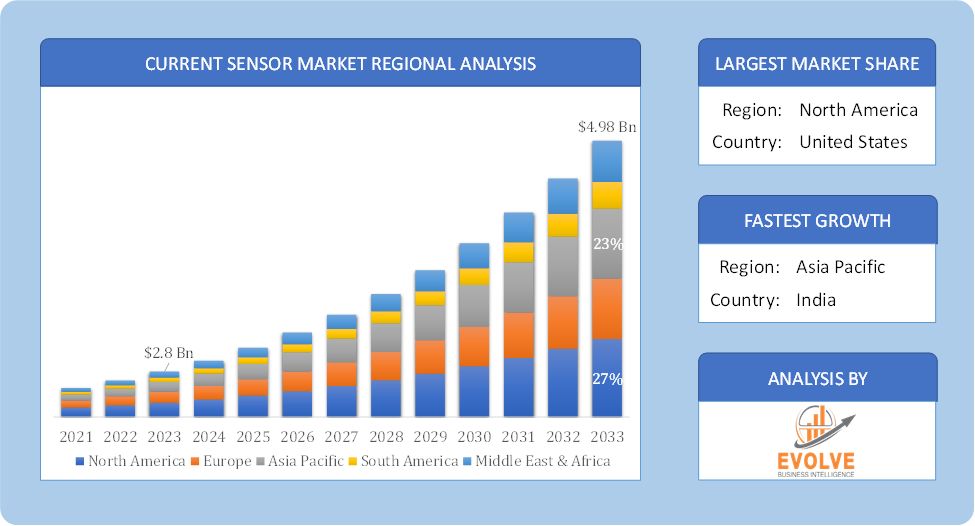 Current Sensor North America Market
Current Sensor North America Market
North America holds a dominant position in the Current Sensor Market. North America is a leader in adopting new technologies, especially in sectors like automotive, industrial automation, and healthcare, where current sensors are widely used. The increasing adoption of electric vehicles (EVs) in the U.S. is a significant driver for current sensors, particularly in battery management systems and motor control and with a growing emphasis on energy efficiency and renewable energy, there is rising demand for current sensors in smart grids and energy management systems.
Current Sensor Asia-Pacific Market
The Asia-Pacific region has indeed emerged as the fastest-growing market for the Current Sensor Market industry. The rapid industrialization and urbanization in countries like China and India are driving the demand for current sensors in industrial automation, power management, and infrastructure development. China, Japan, South Korea, India, and Southeast Asian countries are the major markets in this region and the region is a hub for consumer electronics manufacturing, and the demand for current sensors in portable devices, smartphones, and wearables is significant.
Competitive Landscape
The global Current Sensor Market is highly competitive, with numerous players offering a wide range of software solutions. The competitive landscape is characterized by the presence of established companies, as well as emerging startups and niche players. To increase their market position and attract a wide consumer base, the businesses are employing various strategies, such as product launches, and strategic alliances.
Prominent Players:
- Infineon Technologies
- Honeywell International Inc.
- Texas Instruments
- Allegro MicroSystems LLC
- Tamura Corp.
- Tamura Corp.
- TDK Corporation
- LEM International SA
- Eaton Corporation PLC
- Sensitec GmbH
Key Development
In January 2022, Toshiba Electronic Devices & Storage Corporation developed a shunt MOS current sensor-integrated half-bridge module. Power electronics systems can monitor current with high accuracy and minimal power loss when the sensor is used with components like gallium nitride (GaN) power devices. The innovative sensor technique uses a low-voltage MOSFET (metal oxide semiconductor field effect transistor) connected to a GaN field effect transistor to sense current.
Scope of the Report
Global Current Sensor Market, by Current Sensor
- Open loop
- Closed loop
Global Current Sensor Market, by End User
- Automotive
- Consumer Electronics
- Industrial
- Telecommunication
- Others
Global Current Sensor Market, by Region
- North America
- US
- Canada
- Mexico
- Europe
- UK
- Germany
- France
- Italy
- Spain
- Benelux
- Nordic
- Rest of Europe
- Asia Pacific
- China
- Japan
- South Korea
- Indonesia
- Austalia
- Malaysia
- India
- Rest of Asia Pacific
- South America
- Brazil
- Argentina
- Rest of South America
- Middle East & Africa
- Saudi Arabia
- UAE
- Egypt
- South Africa
- Rest of Middle East & Africa
| Parameters | Indicators |
|---|---|
| Market Size | 2033: USD 4.98 Billion |
| CAGR (2023-2033) | 10.65% |
| Base year | 2022 |
| Forecast Period | 2023-2033 |
| Historical Data | 2021 (2017 to 2020 On Demand) |
| Report Coverage | Revenue Forecast, Competitive Landscape, Growth Factors, and Trends |
| Key Segmentations | Current Sensor, End User |
| Geographies Covered | North America, Europe, Asia-Pacific, South America, Middle East, Africa |
| Key Vendors | Infineon Technologies, Honeywell International Inc., Texas Instruments, Allegro MicroSystems LLC, Tamura Corp., Tamura Corp., TDK Corporation, LEM International SA, Eaton Corporation PLC and Sensitec GmbH. |
| Key Market Opportunities | · Rising Adoption of Renewable Energy Systems
· Innovations in Current Sensor Technology |
| Key Market Drivers | · Advancements in Consumer Electronics
· Rising Demand for Healthcare Equipment |
REPORT CONTENT BRIEF:
- High-level analysis of the current and future Current Sensor Market trends and opportunities
- Detailed analysis of current market drivers, restraining factors, and opportunities in the future
- Current Sensor Market historical market size for the year 2021, and forecast from 2023 to 2033
- Current Sensor Market share analysis at each product level
- Competitor analysis with detailed insight into its product segment, Government & Defense strength, and strategies adopted.
- Identifies key strategies adopted including product launches and developments, mergers and acquisitions, joint ventures, collaborations, and partnerships as well as funding taken and investment done, among others.
- To identify and understand the various factors involved in the global Current Sensor Market affected by the pandemic
- To provide a detailed insight into the major companies operating in the market. The profiling will include the Government & Defense health of the company’s past 2-3 years with segmental and regional revenue breakup, product offering, recent developments, SWOT analysis, and key strategies.
Frequently Asked Questions (FAQ)
What is the growth rate of the global Current Sensor Market?
The global Current Sensor Market is growing at a CAGR of 10.65% over the next 10 years
Which region has the highest growth rate in the market of Current Sensor Market?
Asia Pacific is expected to register the highest CAGR during 2023-2033
Which region has the largest share of the global Current Sensor Market?
North America holds the largest share in 2022
Who are the key players in the global Current Sensor Market?
Infineon Technologies, Honeywell International Inc., Texas Instruments, Allegro MicroSystems LLC, Tamura Corp., Tamura Corp., TDK Corporation, LEM International SA, Eaton Corporation PLC and Sensitec GmbH are the major companies operating in the market.
Do you offer Post Sale Support?
Yes, we offer 16 hours of analyst support to solve the queries
Do you sell particular sections of a report?
Yes, we provide regional as well as country-level reports. Other than this we also provide a sectional report. Please get in contact with our sales representatives.
Additional information
| Packages | Single User License, Enterprise License, Data Pack Excel |
|---|
Table of Content
[html_block id="7982"]
